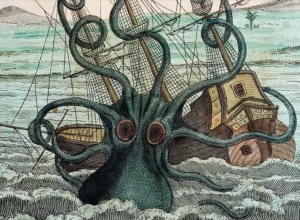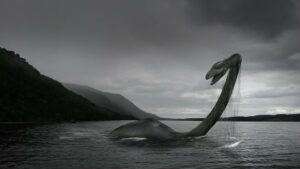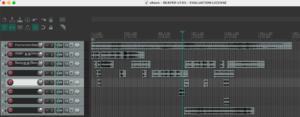Layer 1: Sea Monsters
The inspiration for the first layer comes from my research towards thalassophobia. Jarrett (2022) argues that there is a significant relationship between thalassophobia and mythology. Ancient and modern myths of deep-sea monsters have impressions on the collective consciousness, influencing the perceptions and fears associated with the deep sea and shaping individuals’ experiences of thalassophobia.
Based on my findings on sea monsters across various cultural myths and legends, it’s evident that they are often described as exceptionally large creatures.

Figure 1. Kraken

Figure 2: Loch Ness Monster

Figure 3: Leviathan

Figure 4: Hydra
To create the sounds for these sea creatures, I applied Mconvolution on self-recorded material to make them sound mysterious and distorted. I focused more on generating low-frequency, creature-like sounds to correspond with the giant size of these sea monsters. The siganificant low frequencies serve to show their enormity and provide a sense of dread. Additionally, I incorporated reverb into the monsters’ sounds to give a sense of the deep, dark expanse of the sea, enhancing the eerie and ominous atmosphere surrounding them.

Figure 5: Using Mconvolution
The sounds of Siren are the high-frequency sounds that were created in this layer. I pitched up a synth violin and applied a reverb to make these sounds more ethereal and mysterious.

Figure 6: Siren
Layer 2: Choas
The sounds in this layer draw inspiration from research on the physical and mental symptoms associated with thalassophobia. Studies, like that by Bence (2023), highlight common experiences such as dizziness and faintness among individuals with thalassophobia. To deliver this sensation, I layered whoosh sounds to evoke a sense of disarray and chaos. Additionally, I reversed some of the whoosh sounds to further enhance the feeling of dizziness. Introducing high-frequency sounds resembling tinnitus adds an additional layer of disorientation, conveying the sense of dizziness experienced by people with thalassophobia.
I also manipulated some noises through Mconvolution to further highlight the chaos.
This layer is crafted based on Craig’s improvisation.

Figure 7: Collaboration with Music
Layer 3: Unkown
In this layer, my inspiration came from the definition of thalassophobia. Thalassophobia is defined as the persistent fear of vast, deep, and often dark bodies of water that feel dangerous (Anwar, 2021). Specifically, thalassophobia describes a person’s fear of the great unknown in the water (Anwar, 2021). I created some hollow sound effects using Mconvolution, and I applied large reverbs to convey the fear of the unknown.
Furthermore, I incorporated recordings of my voice, which I pitched the recording down and layered together to produce a whisper-like, hollow effect.

Figure 8: Recording my voice
Layer 4: Calmness
The last layer is a peaceful state. Therefore, I used Mconvolution to produce some organic sounds, such as wind, chimes and cave with water sounds. These organic soft sounds contribute to conveying a sense of chill and relaxation with the soft high frequency.
Certain sounds were directly recorded in the studio. These include the crisp sounds of ice cubes gently swirling in water, the delicate touch of a necklace, the pouring of rice, and the subtle rustle of pages turning.
Each sound across the various layers has been carefully trimmed to ensure immediate responsiveness to audience interactions, avioding any delays. This editing enhances the immersive quality of the experience, allowing participants to seamlessly engage with the soundscape and maintain a fluid connection between their actions and the auditory feedback they receive.
Find all the sound effects through the link below:
https://drive.google.com/drive/folders/17_9u3E1jYnotABVYvZ3BxPkt3zhn83_p?usp=drive_link
References
Anwar, B. (2021) ‘Thalasopphobia: Fear of the Ocean‘, TalkSpace, 20 August. Available at: https://www.talkspace.com/mental-health/conditions/thalassophobia/#:~:text=The%20thalassophobia%20definition%20is%20pretty,water%20right%20below%20their%20feet (Accessed: 15 April 2024).
Bence, S. (2023) How Do I Know if I Have Thalassophobia?. Available at: https://www.verywellhealth.com/thalassophobia-5093770 (Accessed: 15 April 2024).
Jarrett, C. (2022) ‘Thalassophobia: Everything you need to know’, BBC Science Focus, 16 July. Available at: https://www.sciencefocus.com/the-human-body/thalassophobia (Accessed: 15 April 2024).
Mythicalcreatures.info (2024) Leviathan. Available at: https://mythicalcreatures.info/characters/leviathan/ (Accessed: 15 April 2024).
Mythicalcreatures.info (2024) The Hydra. Available at: https://mythicalcreatures.info/characters/hydra/ (Accessed: 15 April 2024).
Potts, K. (2014) The hunt for the Loch Ness Monster – valid scientific research or a fool’s errand?. Available at: https://www.abdn.ac.uk/news/6504/(Accessed: 15 April 2024).
Salvador, R. B. & Tomotani B. M. (2014) ‘The Kraken: when myth encounters science’. Medievalists.net. Available at: https://www.medievalists.net/2015/01/kraken-myth-encounters-science/ (Accessed: 15 April 2024).
Villamirella (2024) The legend of Siren Molpé. Available at: https://www.villamirella.it/en-blog/myth-sirena-molpe-palinuro (Accessed: 15 April 2024).

